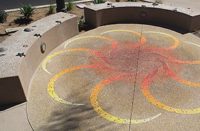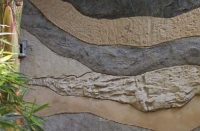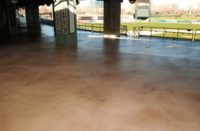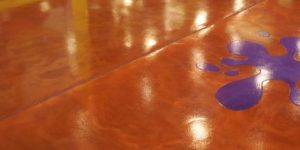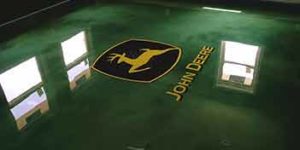
When installing a metallic epoxy system, urethane can be detrimental to a project’s outcome or a welcome addition to its success.
For the longest time my residential garage floors were a three-coat system. I’d start with a coat of epoxy for my primer and then I’d squeegee a 100 percent solids epoxy mixed with metallic pigment from wall to wall across the floor. I never had to worry about product getting into control joints or even large divots. The epoxy would just fill them in and self-level. I’d then apply a topcoat of polyurethane with ultra-violet ray (UVR) protection.

But in some cases, this topcoat didn’t seem to be enough. I had jobs where the outer lip of the garage floors was still exposed to the elements when the door was closed, and that area had the potential to turn yellow. So for about a year, I changed my system to a prime coat of epoxy followed by a coat of metallic pigment mixed with 100 percent solids polyurea UVR. My floors were now 100 percent UVR-protected and I liked that.
Another advantage of using a polyurea UVR is that I didn’t have to wait more than five to 10 minutes to apply whatever solvent I was using for effects.
However, after using this metallic pigment in polyurea method for a year, I discovered I had to contend with some issues. For starters, product that fell into the control joints blistered and ballooned because it was too thick.

When using a 100 percent solids urethane, you must remain within its maximum mil thickness, which is usually around 16 mils. If you exceed the manufacturer’s maximum suggested thickness on the floor, the product will dry soft.
Because I needed to max out the urethane’s mil thickness to achieve that amazing metallic wow factor, I got outgassing from time to time depending on the outside heat index (which is almost always high where I live in Arizona). Outgassing is bad because the hot air rises to the surface and can create bubbles that burst, leaving a marred surface.

So I’ve come to conclude that when installing a multicolored metallic floor, it’s best to use an epoxy prime coat, followed by 100 percent solids epoxy and top-coated with a polyurethane UVR. Take it from me, if you use the urethane UVR as a build coat, the results will be extremely disappointing and will just result in a do-over.
The only time I recommend using a 100 percent solids urethane UVR is when you’re installing a single metallic color on a patio or anything outside. Instead of applying the metallic mixture with a squeegee, use a brush for the control joints and a roller for the floor. The mixture is thinner when you roll it on and thicker if it’s squeegeed.
